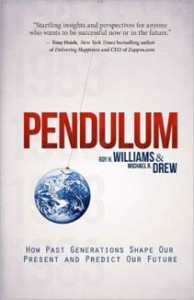Here’s a brief glimpse into pendulum theory…
Yesterday, I referred to a swing of the social pendulum. This theory was first introduced to me by Roy H. Williams in 2004, and I’ve watched it help my clients grow and grow and grow. 
As Williams and co-author Michael Drew note in their book, Pendulum, western society has followed a predictable, rhythmic swing between alternate world views for as long as we have records of history.
It’s a complex, fascinating study, and I highly recommend their book and its terrific companion website, PendulumInAction.com, but the essential thesis is this:
What’s The Pattern?
There’s an 80-year continuum in society, and it’s divided into two 40-year cycles.
The first cycle, a “Me” cycle, is an inwardly-focused, self-centered social pattern whose defining characteristics include a respect and admiration of attractive, individually confident alphas. A “Me” generation’s about big dreams and freedom of personal expression. People want to achieve a better life for themselves through personal liberty.
The other cycle, a “We” pattern, skews toward the opposite set of values. In a “We” pattern, it’s not about big dreams. It’s about small actions. We don’t cheer putting a man on the moon. We cheer walking across the street to give a hungry man something to eat. The goal is not to stand out; rather, it’s about coming together to make the world a better place, consider all of society’s problems, and leverage small actions to build a better society.
What does this mean for your business?
As Rick Levine, Christopher Locke, Doc Searls, and Dave Weinberger presciently predicted about the 21st century of communication in The Cluetrain Manifesto, communication in this generation requires “big values, a little humility, straight talk, and a genuine point of view.”
[Tweet “”This generation requires ‘big values, a little humility, straight talk, and a genuine point of view.'””]
We want the truth… even if it’s ugly. Conversations are “open, honest, uncontrived,” they continued.
And what about that traditional voice of your marketing and advertising?
“That homogenized ‘voice of business?’ That sound of mission statements and brochures? It will soon sounds as contrived as the language of the 18th century French court,” wrote the Cluetrain authors.
And we’ve seen it to be true time and again with our clients and their professional communication.
The World Today
Today, we buy what we buy to remind ourselves – and tell the world around us – who we are. Decisions to purchase today are largely the result of shared values with a company we respect and who mirrors our deeply felt convictions of the world.
We are drawn to them more – and easier – than ever before. Consumers are watching to see what you do, and in this interconnected world, so are their friends – all eager to use posts, likes, tweets, videos, pictures, texts, and blogs to tell their friends on your behalf… or against your best wishes.
The time for arrogance and for shining the spotlight on yourself is over. The loudest, most creative, shiniest, expensive ad campaigns mean nothing if consumers are telling people you’re fake.
But if you prefer loud, flashy, arrogant, and selfish, I have some good news for you. Your way of thinking will slowly start coming back into fashion before you now it.
Just set your watch for 2040 or so.
In the meantime, give us who you really are. As Carl Rogers said, “what you are is good enough. Be it openly.”

Leave a Reply